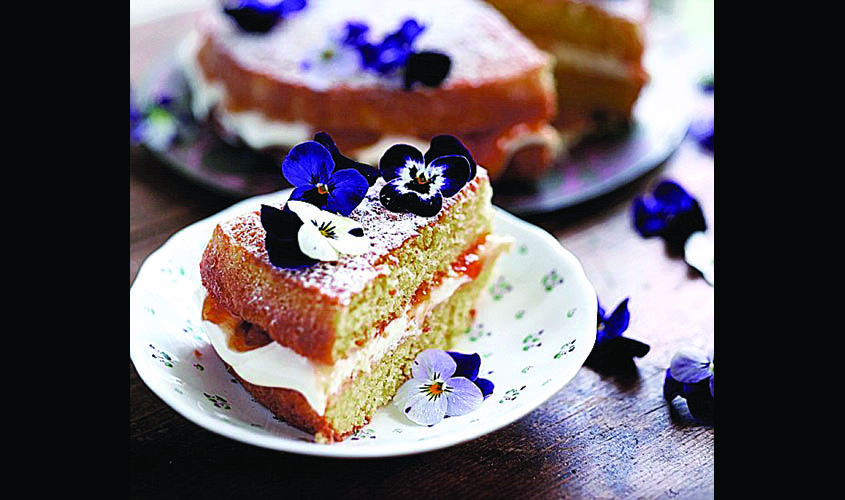The constantly evolving Indian palate has recently welcomed edible flowers as an innovative and popular ingredient. These flowers are being embraced for providing flavour, aroma, texture, colour and decoration to various dishes. While the presence of flowers in the Indian culinary heritage goes way back, their entry into the recipes of contemporary dishes is fairly new.
These days, restaurants are paying special attention to floral ingredients and products. What has led to the acceptance of mixes of seasonal flowers and various blossoms? It’s the increasing affliction towards experimental dishes and growing concern over health.
It’s true that traditionally, we’ve been consuming blossoms like hibiscus, jasmine (mogra) and roses. Others in their flowering stage like banana, cucumber and pumpkin also feature frequently in the history of Indian cuisines. Be these fried into fritters, flavoured into teas or made into gravies, they’ve been significant in our home cooked meals. But one can’t deny that when it comes to plant produce, flowers are often ignored as an edible component for preparing dishes.

Chef Rajat Panwar of Brew Buddy elaborated on the diverse usage of floral ingredients.“Edible flowers have many culinary uses. It gives a blooming hue to the dishes. Edible flowers are used in various forms—fresh, frozen, dried, crystallised or as foam in molecular gastronomy such as in meat and fish dishes, pastas, salads, soups and desserts. Some common forms of edible flowers are found in garnishes, candied sweets, confits and jellies, pickled flowers or flower vinegars. Others are seen in flavourings such as essences and spice blends, food dyes and colourings, teas, infusions and tisanes, flavoured waters and syrups, liquors, cordials, bitters, wine, beer and mead,” he said.
Flowers can be eaten as main part of a meal, incorporated into salads or used as herbs. They have been a part of regional cuisines in Asian, European, and Middle Eastern countries.
There is a great demand in the global market for natural products derived from plants now. The edible flowers have numerous nutrients in their constitution, which are beneficial for health. Thus, edible flower extracts or the fresh flowers are now being seen as a viable alternative to synthetic antioxidants in the food, pharmaceutical and cosmetology industries.
When it comes to the flowers cooked in home kitchens, the frontrunners are South Indian and Bengali cuisines. Banana blossom recipes are famous in both for being healthy and delicious. Moringa, or drumstick, is a loved vegetable in sambar and other main course items. Mint flowers make an appearance in desserts like custards or as a garnish for drinks. They can also blend well with other vegetables in addition to benefiting health in various ways.

Conventionally, delicate chamomile flowers are dried and steamed into hot water for making soothing teas. They consist a herbal flavour known to cure common cold. Marigold extracts are also used as a salad dressing, and favoured for its vibrant colour in food presentation. It also contributes to a range of soothing teas.
Flowers can be added to beverages and spreads such as fruit preserves or butter, and to vinegar, marinades, and dressings. So the concept has as much to do with taste, as for aesthetic purposes.
Chef Vaibhav Bhargava of The Drunken Botanist resto bar told us, “Indeed, the colours that flowers bring to a dish are vibrant. I use orange nasturtium flower in my salmon tataki with Osetra caviar as the flowers are easy to grow from seed and pair well with fish.” Japan’s sakura flowers, cherry blossoms are used for a dish Hamachi sashimi—smoked with sakura wood for a floral aroma, from the menu. Chef Bhargava uses a sakura flower dressing, prepared by mixing the flowers with salt, lemon juice, rice vinegar, salad oil, sugar and light soy for his signature micro herb salad. A few dianthus petals are added to the salad for colour and taste. He insisted that flowers add a new dimension in Oriental cooking.
He gave some pointers on using edible flowers. Organically grown produce is the best as they have strong fragrance. Flowers are also consumed for sustenance. Many flowers that are technically edible can be far from palatable, so one has to be careful with the selection, he informed us.
Chef Anas Qureshi of Molecule Air Bar, Gurugram shared his knowledge about the concept of edible flowers that is now a global trend. “Flowers like chive can be excellently sprinkled over salads, pickled in a quick pickle brine, or scattered over cheesy scalloped potatoes. Lavender which is wonderful for infusing cream (to use as whipped cream or ice cream later), or in buttery cookies, or an earl grey scented cake or elderflower that has bright, tart sweetness akin to lychee or nectarines and more are best used in different food and drinks,” he said.
Molecule offers a lot of flowers infused drinks and dishes. Their best selling edible flower-based food is the healthy salad using kodo millet paired with hibiscus flower vinaigrette dressing. There are drinks like Konkantini—an organic cocktail, which is a mix of martini and the Kokum fruit, garnished with Calendula flower. The flower is used for treating sore throat, stomach ulcers, among many other health benefits. The bar also serves rum based cocktails infused with lavender syrup and topped with dried rose petals etc.
Sanchayan Jana, mixologist at Pra Pra Prank talked about botanic beverages being a huge trend recently. “From lavender lattes to elderflower cocktails, and from hibiscus teas to rose-flavoured milkshakes, one just can’t get over the essence of edible flowers,” he said. Flower is the main ingredient in few of their signature drinks like Early Morning Sour— earl grey tea infused with gin, lavender flower and Orange Marmalade, and Fragrance No 9—gin and rose with elderflower.
Edible flowers have definitely extended their presence from age

